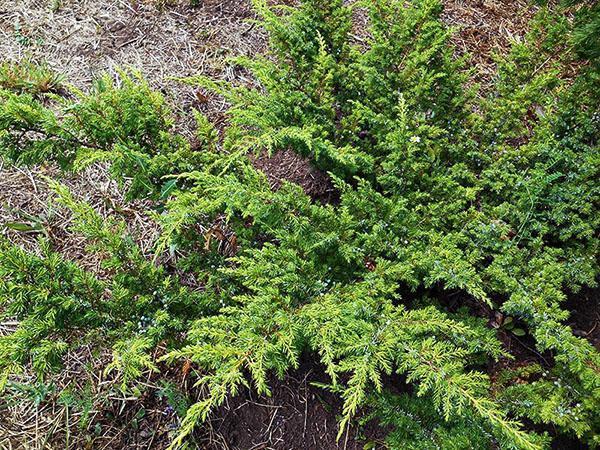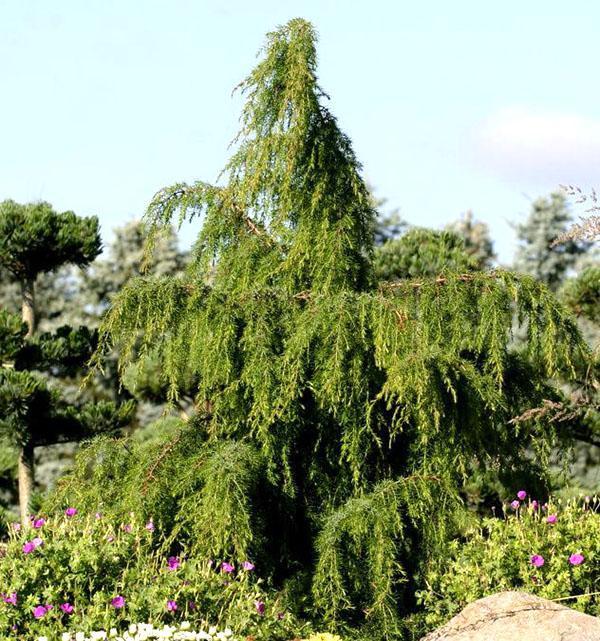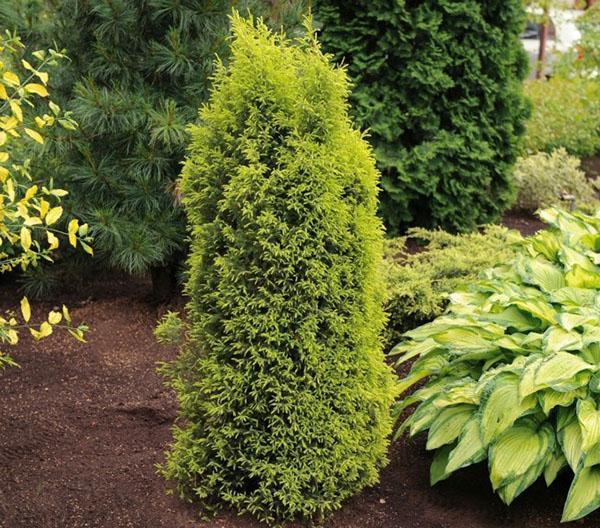Description of varieties of common juniper to help the summer resident
 The common juniper is the most widespread, typical, but by no means the most common species of the extensive genus. It is difficult to imagine a group of plants, whose representatives could look like 10-meter trees, large shrubs with a pyramidal or drooping crown, as well as very low, creeping specimens of the elfin tree.
The common juniper is the most widespread, typical, but by no means the most common species of the extensive genus. It is difficult to imagine a group of plants, whose representatives could look like 10-meter trees, large shrubs with a pyramidal or drooping crown, as well as very low, creeping specimens of the elfin tree.
The common juniper can be found in Europe and North Africa, Asia and the North American continent. Plants prefer a temperate climate, are extremely unpretentious and live in the most unpretentious conditions for several hundred years. Vitality and adaptability to external conditions helped the juniper survive many climatic disasters and survive to this day.
Description of common juniper (Juniperus communis)

Differing in size and type of crown, plants from different parts of the world have given rise to stable forms. By the type of branching and type of shoots, plants are most often distinguished:
- with a wide squat crown and hanging shoots f. Pendula;
- with a wide columnar crown and a few drooping shoots f. Suecica;
- with a narrow low crown in the form of a column f. Compressa;
- with a compact, spreading, spreading crown f. Depressa;
- with a narrow vertical crown and branches directed upwards f. Hibernica;
- with a spreading wide crown f. S.
There are other varieties, named after the discoverers or where they were discovered.
Like the shape, the color of the crown is varied. juniper... In a typical plant of this species, the thorny lanceolate needles on the front side have a noticeable groove, a glossy surface and a characteristic light strip. The basic color of the needles is about one and a half centimeters long - deep green with a bluish tint. Today, gardeners and landscape designers have varieties of common juniper with practical blue (Blue) or golden (Aurea) needles of young shoots at their disposal.
 The branches of this type of juniper are covered with reddish bark, which turns brown with age and begins to flake off the wood. At about ten years of age, plants acquire the possibility of seed reproduction. After pollination on female specimens, round, dense cones are formed, hiding three seeds each and ripening in the second year after emergence.
The branches of this type of juniper are covered with reddish bark, which turns brown with age and begins to flake off the wood. At about ten years of age, plants acquire the possibility of seed reproduction. After pollination on female specimens, round, dense cones are formed, hiding three seeds each and ripening in the second year after emergence.
Forms and varieties of common juniper
 Wild varieties of juniper have become fertile ground for the work of breeders.
Wild varieties of juniper have become fertile ground for the work of breeders.
On the basis of the common juniper, many varieties have been obtained, which are usually classified depending on the size of the plant and its growth rate:
- Junipers that add 30 cm each year are considered full-grown.
- Medium-sized plants grow by 15 or a little more centimeters per season.
- The annual growth of dwarf junipers is 8-15 cm.
- Junipers belonging to miniature varieties increase their size by no more than 8 cm.
- The lowest growth rates are in plants from the micro group, growing by 1–3 cm per year.
Common juniper varieties with drooping branches often do not fit any group, and their growth goes in different directions. This is how nature creates unique, weeping plants.
Juniper ordinary Horstmann (Horstmann)
 An example of such a bizarre, asymmetrical shape is the juniper found in the swamps of Germany. A plant with medium growth rates reaches a height of 1.5–2.5 meters a few years after planting. Although at the beginning of growth the shoots are directed upward, elongating, they droop, forming the original crown of the Horstmann common juniper. This light-loving and unpretentious plant has green thorny needles, coarsening on adult branches.
An example of such a bizarre, asymmetrical shape is the juniper found in the swamps of Germany. A plant with medium growth rates reaches a height of 1.5–2.5 meters a few years after planting. Although at the beginning of growth the shoots are directed upward, elongating, they droop, forming the original crown of the Horstmann common juniper. This light-loving and unpretentious plant has green thorny needles, coarsening on adult branches.
IN landscape design juniper of this variety is always the center of the composition, catching the eye and making you wonder at the fantasy of nature.
Juniper ordinary Repanda
 One of the most common forms of juniper is a shrub with a flat, round or creeping crown. The height of the common Repand juniper does not exceed 30 cm, but the branches grow in breadth to a diameter of one and a half meters.
One of the most common forms of juniper is a shrub with a flat, round or creeping crown. The height of the common Repand juniper does not exceed 30 cm, but the branches grow in breadth to a diameter of one and a half meters.
A variety from Ireland without signs of damage can withstand frosts of forty degrees, but in a continental climate, the bushes can suffer from excessive dryness of the air. According to the description, the common juniper of this variety has non-thorny needles bent inward, slightly less than a centimeter long. The crown is green with a silvery shade formed by light stripes on the needles.
Juniper ordinary Green Carpet (Green Carpet)
 In shape, the common juniper Green Carpet is very close to the Repanda variety. Its name is very eloquent. Indeed, the shrub growing horizontally forms a green carpet only 10–15 cm high. Due to its short stature, the plant is not afraid of cold winters, does not suffer from wind and withstands frosts down to -40 ° C.
In shape, the common juniper Green Carpet is very close to the Repanda variety. Its name is very eloquent. Indeed, the shrub growing horizontally forms a green carpet only 10–15 cm high. Due to its short stature, the plant is not afraid of cold winters, does not suffer from wind and withstands frosts down to -40 ° C.
Juniper ordinary Hibernica (Hibernica)
 Another Irish variety of common juniper has the shape of a narrow pyramid or column. The plant has been in culture for about 200 years. The shrub is valued for its bright needles that do not fade in winter and a dense crown formed by shoots growing upward. An adult juniper reaches a height of 4 to 8 meters, adorning the garden with green-blue soft needles throughout the year.
Another Irish variety of common juniper has the shape of a narrow pyramid or column. The plant has been in culture for about 200 years. The shrub is valued for its bright needles that do not fade in winter and a dense crown formed by shoots growing upward. An adult juniper reaches a height of 4 to 8 meters, adorning the garden with green-blue soft needles throughout the year.
In Russian conditions, the common juniper Khybernika does not survive the winter everywhere. The plant's hardiness limit is –17 ° C.
Juniper ordinary Arnold (Arnold)
 The height of an adult shrub of this variety does not exceed one or two meters. Arnold common juniper plants are distinguished by a narrow, column-or pyramid-like shape, an increase of only 10 m per year, as well as spiny short needles of a greenish-gray or silver-blue hue.
The height of an adult shrub of this variety does not exceed one or two meters. Arnold common juniper plants are distinguished by a narrow, column-or pyramid-like shape, an increase of only 10 m per year, as well as spiny short needles of a greenish-gray or silver-blue hue.
Juniper ordinary Meyer (Mayer)
 In the middle of the last century, the German breeder Erich Mayer produced a variety of common juniper with a wide, pyramid-like crown. The light-loving and frost-hardy shrub grows up to three meters in height and is named after its creator.
In the middle of the last century, the German breeder Erich Mayer produced a variety of common juniper with a wide, pyramid-like crown. The light-loving and frost-hardy shrub grows up to three meters in height and is named after its creator.
Among landscape designers and lovers of conifers, Meyer's common juniper is valued for its decorative crown and silvery-green needles covering it. The spiky needles with a glossy finish resemble spruce needles, making the juniper look like the popular ephedra.
Common juniper Suecica
 Common in the northern part of Europe and Russia, the common juniper Suetsika does not retain a single pyramidal shape. The shrub forms several trunks at once, reaching a height of 10 meters as they mature. The whimsical crown consists of many upright branches drooping at the ends.A variety with a small annual growth, high winter hardiness and excellent decorative qualities easily finds a place in the design of summer cottages, parks and city squares.
Common in the northern part of Europe and Russia, the common juniper Suetsika does not retain a single pyramidal shape. The shrub forms several trunks at once, reaching a height of 10 meters as they mature. The whimsical crown consists of many upright branches drooping at the ends.A variety with a small annual growth, high winter hardiness and excellent decorative qualities easily finds a place in the design of summer cottages, parks and city squares.
Planting and caring for common juniper
 Common juniper is a light-loving evergreen plant, thanks to its unpretentiousness, it takes root in partial shade conditions. At their summer cottage, a sunny, wind-protected place with a light, moderately nutritious soil is selected for the plant.
Common juniper is a light-loving evergreen plant, thanks to its unpretentiousness, it takes root in partial shade conditions. At their summer cottage, a sunny, wind-protected place with a light, moderately nutritious soil is selected for the plant.
The shrub is transferred to the ground in the spring, in April or May, or in the fall, before the arrival of frost. To simplify the care of the common juniper after planting, the pit is prepared in advance.
- The bottom of the pit, somewhat larger in size than the root system of the shrub, is lined with a drainage layer of brick chips, sand or expanded clay.
- Then a mixture is prepared on the basis of sod land, sand and peat with the addition of clay.
- As additional nutrition, nitrogen-phosphorus fertilizers are added to the soil.
- If the soil is acidic, add dolomite flour to it.
- Planting is carried out in 10 - 15 days, when the soil settles.
- The seedling is placed in the pit so that the root collar is a few centimeters above the soil or flush with it.
- After filling the hole, the soil is compacted and watered, and then the circle is mulched abundantly.
The description of the common juniper includes a mention of the unpretentiousness of the plant. This is so, so caring for the shrub is not difficult. In hot weather, planting is watered. Irrigation will help maintain the tone and decorativeness of the needles.
The processing of the soil under the juniper consists in shallow loosening, weeding and spring feeding using complex mixtures for decorative conifers. If the plant is planted in rocky or sandy soil, fertilize more often.
 If the plants planted on the site are to become a hedge, a regular but neat shearing of the common juniper is carried out. It is carried out in the spring or at the beginning of summer so that the growth that appears by the winter becomes stronger.
If the plants planted on the site are to become a hedge, a regular but neat shearing of the common juniper is carried out. It is carried out in the spring or at the beginning of summer so that the growth that appears by the winter becomes stronger.
Junipers do not grow as fast, so the wrong pruning will remind yourself for a long time. Drooping and creeping plants do not cut.
In the fall, they carry out sanitary pruning of common juniper, clean the soil of plant residues, spray the shrub and the soil under it with Bordeaux liquid or another fungicide. Adult plants adapted for wintering in a particular region are not covered for the winter. The crowns of young junipers are fixed with twine, covered with spruce branches and sprinkled with snow.
I liked it very much